A mystery killer is striking thousands of farming families in Sri Lanka’s North Central Province. Insidious as it is deadly, the clues to its identity may flow in the groundwater that irrigates crops and slakes thirsts.
Balmy breezes ripple through vividly green paddy fields. The fertile lands in the North Central Province of Sri Lanka present one of the most beautiful vistas in the island; it has been the traditional rice bowl for thousands of years. However, over the past 20 years or so a chronic kidney disease of an unknown aetiology or cause (CKDu), has killed approximately 20,000 paddy farmers1. Health officials and scientists have been unable to determine the exact cause of this slowly progressive, new type of kidney disease. The only agreement seems to be that the usual risk factors for kidney disease (diabetes, hypertension and urinary tract infection) are rarely present, and that heavy metal contamination and hardness of groundwater are implicated among the other factors involved.
Exact numbers are unknown, but the Ministry of Health estimates that up to several hundred thousand people may be affected. The clusters occur in the North Central, Uva and Eastern provinces, falling mainly within the Dry Zone of Sri Lanka. Victims are mostly subsistence farmers between 30 and 60 years of age, with men 2.5 times more susceptible than women. It has been estimated that over 15.3% of the population in endemic areas are suffering from the disease2.

Similar CKDu hot spots have developed in agricultural communities in India and Central America over the same period of time. However, in India, outbreaks are fewer and more highly concentrated geographically, with equal prevalence amongst poor rural men and women. In Central America, CKDu is killing many thousands of mostly young, male, destitute sugarcane workers. The varying patterns of the disease from region to region and village to village have complicated the picture further. What is clear is the difficulty for researchers to pinpoint the cause of the disease.
Agrochemicals play hide and seek
Renal biopsies of Sri Lankan victims of CKDu indicate a high probability of toxin exposure as being the most likely cause of kidney failure. It has now been established that heavy metals such as mercury, chromium, uranium, lead, arsenic, cadmium and fluoride in certain concentrations are nephrotoxins (kidney poisons)3. Last year, the Sri Lankan government banned the importing of three major agrochemical products as studies suggested a possible link with indiscriminate and excessive use of agrochemicals, but then reversed it. Earlier this year, the government banned glyphosate-based weedicide. Farmers are rarely seen using protective gear, and it is not known whether agrochemicals are being applied to crops in the recommended quantities and methods. The safe disposal of residues, containers, etc., is another concern. Adding to the confusion is the fact that the use of agrochemicals is less intensive in rice farming than in vegetable farms in the hill country where CKDu is unknown.
Studies to date have considered factors such as genetic predisposition, very hot working conditions over many years, changes in traditional diets and even the use of traditional herbal medicine as being possible causes for this disease.
There has been little consensus on this within the research community in Sri Lanka. A recent discussion suggests a correlation between underlying rock composition, configuration of aquifers and the unique chemistry of the groundwater at CKDu clusters. Large depressions in underground aquifers may hold water contaminated with heavy metals, which becomes more concentrated until it is pumped up. The theory may explain the clustering and why the link to agrochemicals is still inconclusive, but dismisses cadmium involvement3.
In August 2013, the CKDu National Research Project and the World Health Organization (WHO) published findings of a joint study2. In over 30% of those affected by CKDu, pesticide residue levels were above minimum safety levels, which demonstrated the extent and persistence of their environmental distribution. The researchers established a correlation between increasing levels of cadmium in the urine in advanced cases of CKDu.
They also reported a deficiency of selenium and a genetic predisposition as possible triggering factors for the onset of CKDu. The study concluded that chronic exposure to low levels of cadmium throughout the food chain, from agrochemical-contaminated groundwater, is the most significant risk factor for CKDu. However, none of these studies clearly and conclusively explain a plausible pathway for the disease, bringing together all the evidence including clinical symptoms, unique clusters of outbreaks, occurrence of hard water and the sudden appearance of the disease in the mid-1990s.

A new study4 published in February 2014 has scrutinized the chemical behavior in groundwater of the compound glyphosate in the most widely used weedicide applied in the area. It has been found that, in conditions prevailing in the CKDu outbreak areas, glyphosate forms deadly poisons with heavy metals and hard water. The findings directly correlate the period of onset of the disease with the first use of glyphosate containing agrochemicals in Sri Lanka in the mid-1990s4.
Connecting the dots
Herath Manthrithilake, Head, Sri Lanka Development Initiative at IWMI, said, “More research is required. It is a serious humanitarian situation. A pervasive social stigma has developed over the disease, and affected communities don’t want to discuss it. They are frightened that no one will marry their young people as news travels from one village to the next.”
While researchers continue to search for answers, victims and their families battle misery, despair and deepening poverty, as they spend all their resources on seeking medical treatment. Health services in the affected areas are overwhelmed but offer kidney dialysis, normally prohibitively expensive, where facilities exist. Steps are also being taken to strengthen the water supply systems in the affected areas, and to tighten the regulations on the procurement and distribution of fertilizers and pesticides.
The disease has silenced some families, but the silence cannot insure them against death. The socioeconomical and human cost of this tragedy will continue to escalate until the cause is found.
1 Ministry of Health, Sri Lanka
2 Jayatilake, N.; Mendis, S.; Maheepala, P.; Mehta, F.R. 2013. Chronic kidney disease of uncertain aetiology: Prevalence and causative factors in a developing country. BMC Nephrology 14: 180. Available at http://www.biomedcentral.com/1471-2369/14/180 (accessed on July 2, 2014).
3 Chandrajith, R.; Nanayakkara, S.; Itai, K.; Aturaliya, T.N.; Dissanayake, C.B.; Abeysekera, T.; Harada, K.; Watanabe, T.; Koizumi, A. 2010. Chronic kidney diseases of uncertain etiology (CKDue) in Sri Lanka: Geographic distribution and environmental implications. Environmental Geochemistry and Health 33(3): 267-278.
4 Jayasumana, C.; Gunatilake, S.; Senanayake, P. 2014. Glyphosate, hard water and nephrotoxic metals: Are they the culprits behind the epidemic of Chronic Kidney Disease of Unknown Etiology in Sri Lanka? International Journal of Environmental Research and Public Health 11(2): 2125-2147.Available at http://www.mdpi.com/1660-4601/11/2/2125 (accessed on July 2, 2014).
Dharshani Weerasekera is an independent development sciences writer. The International Water Management Institute (IWMI) has commissioned this article, but the views expressed are her own.

